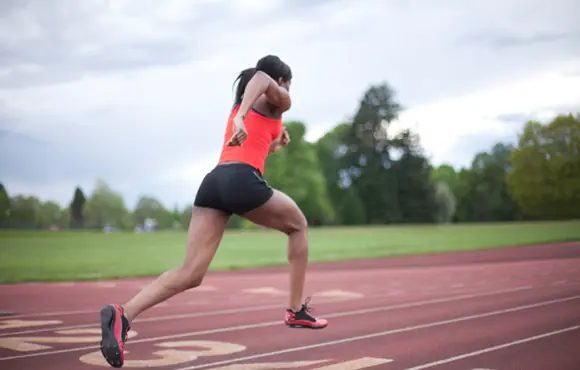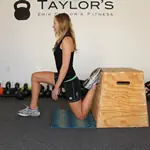Of course, being an athlete isn't your full-time job, but a scaled-down version of this training philosophy is doable for most recreational runners. In addition to your run program, commit to strength training twice a week, perform drills once a week, and complete the injury prevention tasks outlined in this gallery as often as you can. If you invest your time wisely in these things, you'll soon run your best 5K.
5K Workouts for Everyone
1 of 24
While jogging a few miles a few times a week will prepare you to finish, it certainly won't allow you to finish fast. If you want to improve your finish time, it's important to mix in some hard workouts in addition to easy running. Not only will these workouts help improve everything from foot speed to strength, but they'll also bump up your overall fitness in a way that easy runs never will.
We asked coaches around the country to share their favorite 5K workouts, and how these workouts can be adjusted for every pace and experience level.
—Mackenzie Lobby
Gain Confidence From Your Workouts
2 of 24
Confidence is important enough with respect to race performance that you should make a conscious effort to increase it. Since confidence comes primarily through training, this means you need to train for confidence, or train in a way that proves you can achieve your goals.
One way to do this is to plan your training program to culminate in a few key confidence-building workouts that, by their design, are highly predictive of performance in the specific race you're preparing for.
—Matt Fitzgerald
Don't Get Too Fast, Too Soon
3 of 24
"Speed work is fun and it makes you [get] fast quickly," Elizabeth Waterstraat, coach and founder of Multisport Mastery says. "But you only need to do about six weeks of it to get the benefits." Do it too early in the spring and you're going to peak in early summer. "If your races aren't until later, too much speed work too early can leave you burned out or even injured by race day."
—Marty Munson
How to Vary Workouts During Your Training Cycle
4 of 24
Workouts should be general early in your training cycle (months before your goal 5K race). As you build your fitness, the workouts gradually become more challenging and specific.
Start with easy runs and incorporate some short speedwork like strides. Strides are simply accelerations done after your run where you build to about 95 percent of your maximum speed, hold this pace for a few seconds, and then coast to a stop. Strides are fast, but they're also very short.
—Jason Fitzgerald
Run Faster Than Goal 5K Pace
5 of 24
If you want to improve your leg speed, you need to do some work that is faster than 5K goal pace. At a minimum this means strides that are faster than 5K pace. I assign strides to my athletes the day before workouts so that the neuromuscular system is challenged just a bit, making the race-pace work the next day feel comfortable. You could do 4 x 30 seconds at faster than 5K pace with 60 to 90 seconds of slow jogging in between near the end of your easy day run.
—Jay Johnson
How Hill Workouts Can Increase Your 5K Speed
6 of 24
"In general, hill training improves overall strength while doing real time running," explains Dan Flynn, a coach based in Boston, Massachusetts. "Many people don't activate their glutes when they run, which can lead to problems. Running up hills forces you to do that." That added strength in the leg muscles will translate into better efficiency over added mileage and intensity. Not to mention, an overall stronger kinetic chain means fewer injuries and hiccups in training.
—Mackenzie Lobby
Prep Your Body to Race With 5K-Specific Efforts
7 of 24
While more advanced runners are likely running workouts every week, to truly reach your potential and run a new personal best, it's important that the workouts during your peak training phase are specific to the demands of your goal race.
In this case, the peak workouts must mimic what you'll experience during your 5K on race day. Sure, 400m intervals have their place in a good 5K training program, but they're not as specific to the demands of the race.
The following two workouts should be completed on a track so you can monitor your split times more accurately.
—Jason Fitzgerald
2 Moves to Increase Power and Agility
Two-Leg Hurdle Hop 8 of 24
Position eight hurdles in a row, 45 inches apart, with the height of each hurdle set at 23 inches. Starting from one end, jump over each hurdle, landing and taking off on two legs until all eight hurdles have been cleared. Maintain continuous movement. Minimize ground-contact time with each landing, and try to be as explosive as possible. Once you have cleared the eighth hurdle, jog back to the beginning point and repeat four more times for five reps in all. Avoid taking little hops between hurdles and making more than one contact between hurdles. This exercise may also be performed on one leg at a time as a progression.
—Owen Anderson
7 Plyometric Drills to Boost Economy
9 of 24
Because plyometrics are explosive and require a quick and forceful recruitment of muscle fibers, they are the last building block of a successful strength-training regimen, and should only be implemented in your training once a solid foundation has been built. Following the hard days hard, easy days easy principle, your plyometric workouts should come after your hard workout days. Try these seven plyometric exercises to boost power and improve running economy.
—Jeff Gaudette
Discover Your Weaknesses
10 of 24
Your body isn't two perfect mirror images between right and left; some muscles are naturally stronger than others, and some areas are tighter or looser than others. In other words, all runners have weaknesses that can contribute to getting injured. A runner's imbalances are the slumbering volcanoes for injuries. Interestingly, injuries can manifest in some ways that are tricky to diagnose. You may be having problems in your feet, but the culprit is weakness in your glutes.
—Caitlin Chock
Prevent Lower-Leg and Foot Injuries
11 of 24
When running, the feet are the first and last thing to touch the ground. Muscle dysfunction occurring in the lower leg can alter your running mechanics, eventually resulting in discomfort and possibly injury. Many of these issues can be avoided by simply foam rolling and strengthening these areas; find out how to keep your lower legs and feet healthy.
—Erik Taylor
Why All Runners Need Stronger Hips
12 of 24
The weak link in many runners is their hips. Most likely your hip flexors are tight, and your glutes and the smaller stabilizing muscles are weak. This often leads to Patellofemoral pain syndrome, more commonly known as "runners knee," Iliotibial band syndrome and tight lower backs. How does this happen?
It starts with lack of strength training and mobility exercises, poor running mechanics, overuse, and sitting for long periods of time. These eight exercises will help loosen the hip flexors, and strengthen the surrounding stabilizing muscles. Finding the time to execute these exercises can save you from time off due to injury.
—Erik Taylor
4 Cheap Tools to Prevent Injury at Home
13 of 24
Regrettably, most of the measures that runners experiment with to fix or prevent injuries aren't magical. But there are a few products on the market that work very well to prevent or treat specific injuries in many runners, and some of them cost less than a pair of running shorts. In 30 years of running, I've experienced just about every running injury you can name, and I've tried almost every product that is designed to fix or prevent these injuries. I've accumulated a few favorites to share with you here.
—Matt Fitzgerald
DIY Massage
14 of 24
Runners should complete self-myofascial release using a foam roller or lacrosse ball to keep their structural integrity intact. Massaging overactive soft tissue will reduce any inflammation in your muscles and fascial system, or the sheath that surrounds your muscles. Spend 5 to 10 minutes before your run, then 5 to 10 minutes after your run executing the following exercises three to four times a week for 30 seconds to 2 minutes per area.
—Erik Taylor
Trade Static Stretching for Active Isolated Flexibility
15 of 24
Active Isolated Flexibility (AIF) is not static stretching, or bending over and touching your toes and holding that position for 10 to 20 seconds. AIF employs a rope (or you could use a towel or a dog leash or whatever works) to help you assist the body at the end of the range of motion of the stretch. The muscles in the body work in pairs. If you want to lengthen the hamstring and improve your hamstring flexibility, then you should contract the quadriceps muscle to help this process. It's that simple: Contract one muscle to lengthen the other muscle. This is where the "active" in AIF comes in—you have to activate a muscle group to lengthen the opposing muscle group.
—Jay Johnson
Train Your Core Effectively
16 of 24
Core should mean something very different to a runner. It includes all of the muscles of the lower trunk and pelvis—not only your abs and your back, but also your hip flexors, abductors and adductors, too. The goal of an effective core routine for runners is one that avoids over-targeting or isolating less effective muscle groups, like the abs, and emphasizes the hips, glutes and transverse abdominis.
—Jeff Gaudette
10 Ways to Execute the Perfect Core Exercise
17 of 24
The plank is an effective exercise that has great benefits--it strengthens your core as well as your upper and lower body. But have you fallen into a rut of performing a standard plank all the time? Make the exercise more challenging and dynamic by changing your body position.
—Erik Taylor
10 Running-Specific Strength Moves
18 of 24
Although strength training is excluded from many runners' training programs or treated as occasional cross-training to be carried out on non-running days, it is the backbone of great endurance training. These 10 running-specific exercises will build the strength, agility and explosiveness you need to conquer challenging hill intervals and speed workouts.
—Owen Anderson
Your Last Pre-Race Speed Workout
19 of 24
Before your goal race, it's best to practice two different paces during your final fast workout: goal pace (how fast you'd like to run for 5K) and slightly faster than goal pace. Running at goal race pace helps "hard-wire" that pace into your muscles and brain. The faster pace provides a stimulus that helps prime your body for fast running, reinforces a more economic stride, and can build the muscle tension you need to run fast.
—Jason Fitzgerald
Race to Win (or at Least Blow Past the People Around You)
20 of 24
Fartleking, or throwing surges in during a race, is one tactic to break your competition. Mentally, putting a gap between you and your competition can sometimes be enough to beat them before the finish line. Getting gapped or being stuck in "no man's land" is difficult, and can sometimes be the nail in the coffin for a racer.
If you're able to train your body to fartlek, or surge, in a race and hold it together, you can use it to your advantage and try to break your competition.
Practice fartleking, and get used to various paces. There are tons of different ways to fartlek outside of the traditional one-minute-hard, one-minute-easy formula.
—Caitlin Chock
Race-Pace Strategy for a PR
21 of 24
Running an even pace is the most effective way to run the fastest time, because it utilizes oxygen most economically and keeps lactate accumulation to a minimum. Even pacing requires that you know the correct pace to select, that you have good pace judgment and that you have the discipline to hold back in the early stages of the race, when the pace feels easy.
The best time to learn race pace is during training. When you learn what it feels like to run at your goal pace, it becomes natural for you to maintain that pace during the race. Do some training at your goal pace for important races, so that you can more easily settle into that pace and so that it becomes natural for you to maintain that pace.
—Pete Pfitzinger
What Should You Eat for Breakfast on Race Day?
22 of 24
Even though the distance is only 3.1 miles, your body still needs fuel before running a morning 5K. What and when you eat before your race should be based on what you ate the night before and how early you wake up.
For example, if you ate a well-balanced dinner containing carbohydrates the night before, eating something small—and carbohydrate-focused—30 minutes before the race would be adequate. If you didn't eat much the night before, consider eating something more substantial—that includes fat and/or protein—two hours before the gun goes off.
—Eve Pearson
Should You Take the Day Off After the Race?
23 of 24
While there are certainly instances where your body needs rest, much of the time, an easy run can actually help speed up the recovery process after a hard effort by increasing blood flow in the legs. Not only can this help flush the lactic acid from your muscles, it can also cut down on some of the muscle soreness after a long or hard workout or race.
—Mackenzie Lobby
Get ACTIVE on the Go


Couch to 5K®
The best way to get new runners off the couch and across the finish line of their first 5K.
Available for iOS | Android






Discuss This Article